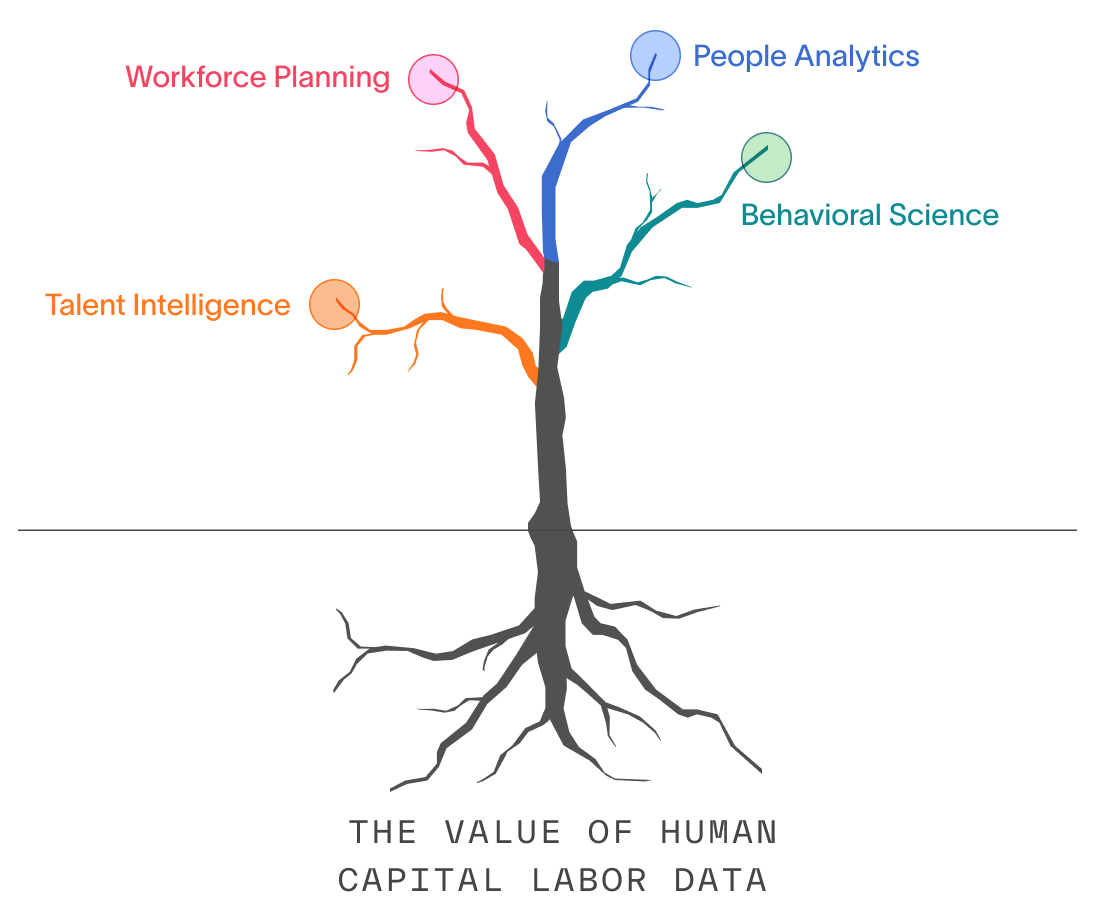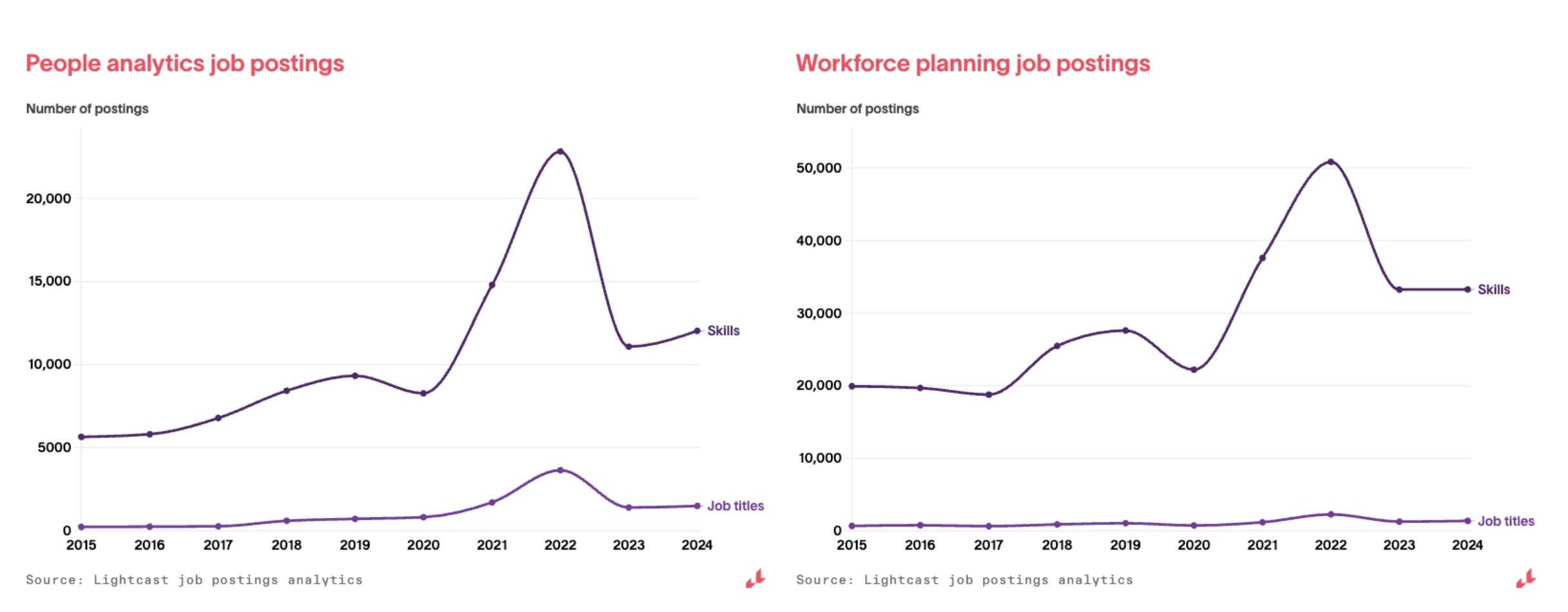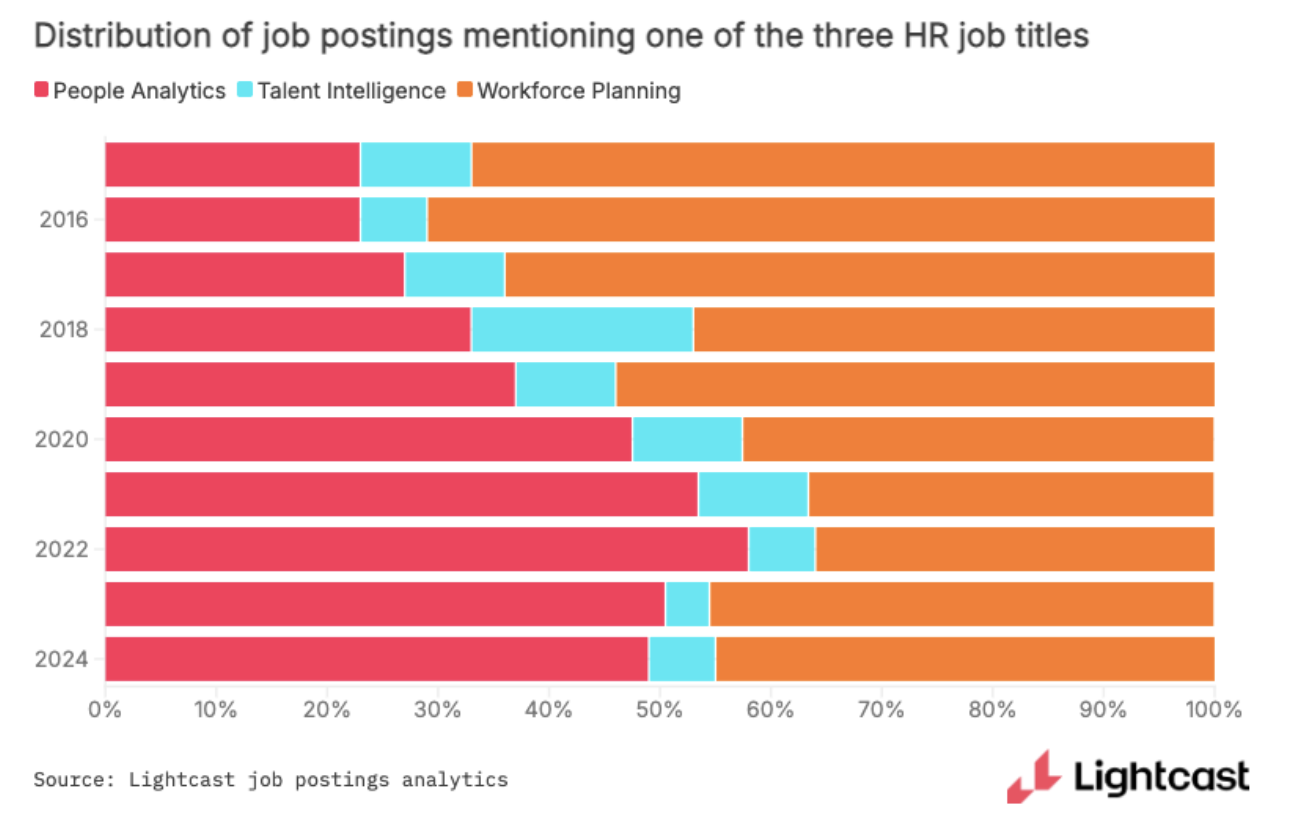How does a new job emerge? When new job trends emerge, they are likely to first appear as skills in other roles. As skills evolve, they consolidate into job titles and eventually into full occupations. With this evolution, specific skill mentions may disappear from job postings as they become ubiquitous and form into job titles - or those mentions may expand more broadly into new roles as the skill becomes decentralized.
As a demonstration of this phenomena, let’s focus on three occupations: People Analytics, Workforce Planning, and Talent Intelligence - all of which are near and dear to my heart.
These are three fundamental disciplines that have consistently had the potential to deliver value to HR and businesses. These disciplines, despite originating independently from one another, actually have the same roots: The value of human capital labor data. Although they are branches, they are all from the same tree, which harkens back to a recent blog post I wrote called Tree of Value. Just as a tree draws strength from its interconnected branches and deep roots, these disciplines—despite their differences—are ultimately working toward the same goals, and their fates are intertwined within the roots of data from which they all draw upon.

Each of the branches of the Tree of Value has distinct origin stories, shaped by unique histories and challenges. Understanding these origins helps us appreciate how they complement one another and why their integration is so critical today, and why their roots in the value of human capital labor data are so intertwined.
Here’s what we mean by people analytics, workforce planning, and talent intelligence:
People Analytics: The scientific approach of collecting and analyzing internal employee data to understand workforce patterns, predict trends, and inform strategic HR decisions.
Workforce Planning: The strategic process of anticipating an organization's future talent needs by aligning human capital requirements with business objectives and operational goals.
Talent Intelligence: The practice of gathering and interpreting external labor market insights to understand talent availability and demand, location strategy, competitive positioning, and the overall skill landscape across an organization’s industry and talent competitors.
________
However, before these were defined disciplines, they started out as skills diffused within the HR function. 10 years ago, the prevalence of people analytics, workforce planning, and talent intelligence skills was lower than today, as there were fewer dedicated roles and teams to these disciplines. Perhaps, even these skills were diffused amongst other HR professions or specialist roles and not explicitly stated.

Rather than skills, what about actual jobs titles posted for during the same period? Was there the same demand?

Look at the correlation of skills and jobs titles being posted. It’s important to note the total postings difference though. There were 10s of thousands of mentions of skills in job postings, but only thousands of job titles being posted for during the same time frame. That’s an order of magnitude difference in demand.
For People Analytics and Workforce Planning, the number of job postings mentioning these skills over the past 10 years outnumbered the job postings mentioning them as job titles. Frankly, job roles were almost nonexistent from 2015 - 2019. Which goes back to the thesis of this article — they started as skills only, and grew to distinct disciplines within HR.

Like the two other branches, Talent Intelligence, is new on the scene, but had little peaks in 2018 and then accelerated in 2021. The skill-job correlation was almost at parity. Then, skills mentions skyrocketed while the number of postings for TI job titles grew at a much slower rate.

As we stated in the Tree of Value blog, workforce planning is the oldest discipline of the three, followed by people analytics, and talent intelligence being the newest of all. As such, it makes sense that you would see the broadest proliferation of workforce planning skills and job titles, with similar patterns for people analytics. Talent intelligence being the newest is still establishing itself as a skill and may not have made the full transition into a job with broad adoption.

However, if you focus solely on job titles, people analytics has gained significant importance over the last decade, really establishing itself as having moved from a skill to a robust job function and occupation itself.
It moved from accounting for only 20% of job postings in relationship to Workforce Planning and Talent Intelligence in 2015, to approximately 50% by 2024. It seems many Workforce Planning roles may have become People Analytics roles showing the drift that sometimes occurs between established disciplines and emerging disciplines.
____________
Why the growth in these skills and roles? As mentioned earlier, these three disciplines bring an immense value to HR and the organizations they support. This can be validated by showing the salary increases in these roles compared to the rest of HR.
People Analytics, Workforce Planning and Talent Intelligence roles median salaries were roughly equivalent to the rest of HR 10 years ago. However, all three occupations outpaced HR salaries in general since then.
The additional in-demand skills for these roles required a wage premium to be able to recruit and retain people in these disciplines, especially as the demand for these positions grew.

In the end, what ties People Analytics, Workforce Planning, and Talent Intelligence together isn’t just their evolution into distinct roles, it’s their shared foundation in human capital data and their collective ability to deliver business-critical value. These disciplines are not isolated practices; they are interdependent branches of the same Tree of Value. And if you’re serious about scaling that value, the best place to start is with Lightcast. We offer the labor market data, insight, and infrastructure that powers all three branches—because when data is your root system, your business can grow in any direction.
We’ll be digging into other disciplines and how they have evolved from skills into jobs in the coming week. Just remember, if you’re looking to do this type of research for your organization, or want to understand the business value of skills and jobs, your search starts with Lightcast.



